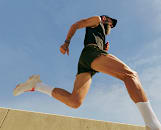
Zbynek Pospisil / iStock / Getty Images Plus via Getty Images
When a Muscle Cramp Strikes Mid-Workout, You Might Want to Eat Mustard—Here’s Why
Don’t knock it ’til you try it.
By Jennifer Heimlich•
Is Mustard Good for Cramps?
Should You Try Mustard for Cramps?
When to Take Mustard for Cramps
More Considerations for Trying Mustard for Muscle Cramps
The Takeaway
Picture this: You’re cruising along during an indoor cycling class, hitting a satisfyingly heart-pumping groove, when a dreaded muscle cramp strikes your quad. Suddenly, you’re grabbing your thigh and stopping your ride short. You text a friend about what happened, and they tell you to go eat some mustard. Wait… mustard for cramps?!
Discover more ways to reach your goals with Peloton
Yep, you read that right. Many athletic trainers swear by mustard for muscle cramps—and there’s some solid research to back it up. Although there’s still a bit of mystery around exactly why it’s so helpful, this trick could be a game-changer for your workouts.
Is Mustard Good for Cramps?
As odd as it might sound, a bit of mustard can be surprisingly effective at quickly stopping a muscle cramp during exercise.
Researchers started investigating this mustard superpower while looking into another famous cramp-fighter, pickle juice. For a bit of background: The pickle juice phenomenon took off in 2000 thanks to a football game between the Philadelphia Eagles and the Dallas Cowboys. Temperatures were over 100 degrees Fahrenheit, and the Eagles’ athletic trainer was giving cramp-prone players pickle juice.
“The Dallas Cowboys were heat acclimated, but their guys are cramping up like crazy,” says Texas State University professor Kevin Miller, PhD, one of the leading researchers on exercise-induced muscle cramps. Meanwhile, “the Philadelphia Eagles, this northeastern team, they’re not cramping at all—and Philadelphia ends up kicking the snot out of the Cowboys. After that, pickle juice blew up.”
Originally, people assumed it worked because pickle juice’s high sodium content helped replace electrolyte loss, thereby stopping the cramp. But research Miller was involved in showed that couldn’t be the case. For starters, they found that a small amount of pickle juice doesn’t actually change the electrolyte balance in the bloodstream. What’s more, it sits in the stomach far longer than the minute or two it takes for athletes to see the cramp-relieving effects. Plus, Miller says it’s more likely that cramps can be blamed on a confluence of risk factors—an extra-hard workout, heat, a bad night’s sleep, stress, and so on—rather than electrolyte loss being the sole cause.
With all that in mind, scientists now believe that pickle juice helps relieve muscle cramps due to its high vinegar content (or more specifically, acetic acid, the main chemical in vinegar), which has an incredibly sour taste that simply shocks our brain out of paying attention to the cramp. “The strong flavor of the acetic acid seems to allow the brain to forget about the cramp and instead focus on this very sharp, very sudden taste sensation in the mouth,” says registered dietitian Stephanie Hnatiuk, RD, who specializes in working with runners. “The brain can only handle so much stimulation,” Miller explains.
So where does mustard come into all this? Well, the yellow condiment is also high in vinegar. That means athletes who can’t stand the taste of pickle juice—or don’t have any easy way to carry it on them during, say, a marathon—can use mustard as an alternative. “The common ingredient in pickle juice and mustard is vinegar, and there’s some literature showing that vinegar activates these receptors in our mouth that can influence muscle activity,” Miller says.
The caveat: Whether you’re using pickle juice or mustard for cramps, the effect is not necessarily instantaneous, and it doesn’t work for everyone. “But in cases where it is successful, it has been shown that cramps can cease within a couple of minutes,” says Stephanie E. Hooper Marosek, PhD, a professor of chemistry at Methodist University, whose 2020 study looked at the effectiveness of various substances—including mustard—in alleviating muscle cramps.
Should You Try Mustard for Cramps?
If you’re prone to cramps during hard workouts, experts agree that it might be worth seeing if mustard can help you out.
“This is something that I recommend to some of my clients who encounter muscle cramping sometimes during races,” Hnatiuk says, who suggests keeping a couple of mustard packets in your pocket during important athletic events. “It’s a pretty low-cost, low-risk type of intervention.”
Unless you have an allergy or other sensitivity to mustard or its ingredients, there aren’t really any downsides to trying this trick every now and then. “But if you are consistently needing to use stuff like this to alleviate cramps, I would want to do a little bit more digging into why you are getting cramps so frequently,” Hnatiuk says.
Miller agrees: “If you want to prevent cramping, you’ve got to do your homework,” he says. He’s created a 16-part questionnaire to identify risk factors, and he says it’s particularly important to rule out any medical conditions that could put you at higher risk of cramping. This can help you zero in on the root causes of your muscle cramps, and may give you a heads up that you should talk with your healthcare provider about them.
Both experts also warn against taking straight shots of vinegar to get directly to the source of that sour-tasting shock in mustard or pickle juice. “Because of the very concentrated acid that you’re then swallowing, it could cause irritation and inflammation in the esophagus, similar to having acid reflux,” Hnatiuk says. Miller admits he tried this once himself, and doesn’t recommend it: “My throat burned for about a day.”
When to Take Mustard for Cramps
Mustard can be useful any time exercise leaves you cramping and you don’t want to step off the gas or take time out to stretch.
“During an event, whether it’s a sport competition or an endurance event, where you want to alleviate that cramp and get back out there and keep performing as quickly as possible, that’s where it would be really helpful,” Hnatiuk says.
She points out that, otherwise, if you cramp up during a day-to-day gym strength training session, you might prefer to seek relief by simply stretching the muscle or pulling back on the intensity rather than shooting back a packet of mustard—but that choice is up to you (and how much you like the condiment).
Hnatiuk also warns that this trick might not work for side stitches the way it does for cramps in other body parts like your legs. “[One] of the theories around a side stitch is that it’s the layers of muscle that are rubbing against each other, not that that muscle is being worked beyond its capacity,” she says. “Also, sometimes that side stitch can be related to GI issues.” That means you might need more than just a sour-tasting distraction like mustard to solve the problem.
More Considerations for Trying Mustard for Muscle Cramps
Intrigued to try some mustard for cramps yourself? Here are a few factors that may be helpful to keep in mind, according to experts:
The type of mustard: So far, the research on mustard for cramps has focused on the plain yellow mustard packets that you can pick up at fast-food chains. But Hnatiuk says there’s no harm in doing some trial and error with Dijon or spicy brown mustard if that’s more your style. “You just want something that has that vinegar content,” she says.
How much to take: Marosek says her study found that one and a half to three packets of mustard will give you the same amount of acetic acid that pickle juice studies have found successfully relieves cramps. But just one packet would likely be enough to do the trick, she says.
When to take it: So far, it’s unclear whether taking mustard proactively before a workout might help prevent cramps from occurring in the first place, since that hasn’t yet been studied, Marosek says. But since there’s little harm in trying it, you could easily test it out to see if it helps you. Otherwise, just keep a packet or two on hand to take when a cramp first hits.
Chasers: Hnatiuk suggests letting the pungent flavor sit in your mouth for a minute or so rather than immediately washing it down with water like you would with a gel. Remember: The point is not to get nutrients into your bloodstream, but to shock your system with the sour taste.
What else might work: Marosek hopes that scientists will one day look into whether other, more palatable sour flavors like lemon or lime could have a similar effect. “Some people might find a citrus flavor preferable to vinegar,” she points out.
No matter how much you love or hate the taste of mustard, don’t forget about other ways to deal with and prevent muscle cramps: Ramp up your training gradually, activate the right muscles with a solid warm-up before every workout (the Peloton App has several 5- to 10-minute class options), avoid exercising in high heat if you can, and stay properly fueled and hydrated. Then, once a muscle cramp hits, your number-one tool is still gentle static stretching of the cramping muscle until it goes away, Miller says.
The Takeaway
If you struggle with muscle cramps, at least take comfort in knowing you’re not alone. “Almost 90 percent of physically active people have had at least one exercise-induced muscle cramp in their lifetime,” Miller says. “So it’s this almost universal phenomenon.”
Although there’s still a lot of unknowns when it comes to the exact physiology of muscle cramps and how we make them go away, mustard has been shown to be one practical and relatively palatable way to find relief when they hit. If you find it helps you, don’t hesitate to keep a small packet or two in your pockets for important races or competitions. Just also make sure you’re thinking about what’s triggering those cramps for you and flagging any concerns to your healthcare provider.
And if you hate mustard? Try pickle juice.

Peloton App
Access thousands of classes with no equipment needed.
This content is for informational and educational purposes only and does not constitute individualized advice. It is not intended to replace professional medical evaluation, diagnosis, or treatment. Seek the advice of your physician for questions you may have regarding your health or a medical condition. If you are having a medical emergency, call your physician or 911 immediately.
Level up your inbox.
Subscribe for a weekly dose of fitness, plus the latest promos, launches, and events.
By providing your email address, you agree to receive marketing communications from Peloton.
For more about how we use your information, see our Privacy Policy.













